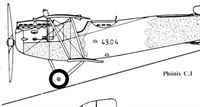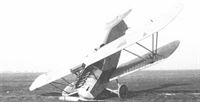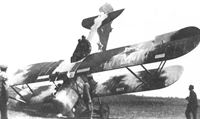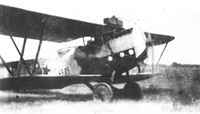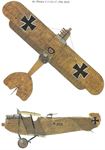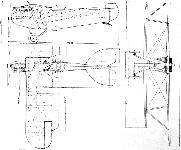
Описание
Страна: Австро-Венгрия
Год: 1917
Фронтовой самолет
Варианты
- Hansa-Brandenburg - D.I/KD - 1916 - Германия
- Hansa-Brandenburg - KDD - 1916 - Германия
- Hansa-Brandenburg - KDW - 1916 - Германия
- Hansa-Brandenburg - W.11 - 1916 - Германия
- Hansa-Brandenburg - C.II / K - 1917 - Германия
- Hansa-Brandenburg - W.25 - 1917 - Германия
- Phonix - C.I - 1917 - Австро-Венгрия
- Phonix - D.I/D.II/D.III - 1917 - Австро-Венгрия
- Phonix - D.IV / 20.24 / 20.25 - 1918 - Австро-Венгрия
- В.Кондратьев Самолеты первой мировой войны
- J.Forsgren Swedish Military Aircraft 1911-1926 (A Centennial Perspective on Great War Airplanes 68)
- P.Grosz, G.Haddow, P.Shiemer Austro-Hungarian Army Aircraft of World War One (Flying Machines)
- E.Hauke, W.Schroeder, B.Totschinger Die Flugzeuge der k.u.k. Luftfahrtruppe und Seeflieger 1914-1918
-
P.Grosz, G.Haddow, P.Shiemer - Austro-Hungarian Army Aircraft of World War One /Flying Machines/
Phonix C.I 121.17, Flik 28/D
-
J.Davilla - Italian Aviation in the First World War. Vol.1: Operations /Centennial Perspective/ (73)
Phonix C.I 121.17, Oblt. Arnold Barwig & Zugsfuhrer Max Kauer. This crew in this aircraft were credited by the Austrians with downing Francesco Baracca.
-
В.Обухович, А.Никифоров - Самолеты Первой Мировой войны
UFAG C I (Phonix C.I ???)
-
P.Grosz, G.Haddow, P.Shiemer - Austro-Hungarian Army Aircraft of World War One /Flying Machines/
Phonix C.I 121.57, Flik 57/Rb
-
J.Forsgren - Swedish Military Aircraft 1911-1926 /Centennial Perspective/ (68)
Phonix C.I 0122 in Swedish service.
-
J.Forsgren - Swedish Military Aircraft 1911-1926 /Centennial Perspective/ (68)
Dront 9102 in Swedish service.
-
J.Forsgren - Swedish Military Aircraft 1911-1926 /Centennial Perspective/ (68)
FVM Hispano-Dront 324 in Swedish service.
-
P.Grosz, G.Haddow, P.Shiemer - Austro-Hungarian Army Aircraft of World War One /Flying Machines/
This view of the Phonix C.I 121.01 prototype shows the inaccessible pilot’s cockpit buried underneath the wing and further confined by the curved center-section strut, a feature much disliked by pilots.
-
P.Grosz, G.Haddow, P.Shiemer - Austro-Hungarian Army Aircraft of World War One /Flying Machines/
The first step in the development of the Phonix C.I was aircraft 121.01, here fitted with Sparmann wings but retaining the short fuselage and tail surfaces of the Brandenburg C.II(Ph) prototype. Flight tests began at Aspern in June 1917.
-
P.Grosz, G.Haddow, P.Shiemer - Austro-Hungarian Army Aircraft of World War One /Flying Machines/
Another step in the evolution of the Phonix C.I was the 121.02 prototype, flight tested in July 1917, with Sparmann wings, a new center section, and longer fuselage to accommodate the relocated pilot’s cockpit that has been moved aft. Like the 121.01, it was powered by a 185 hp Daimler engine.
-
P.Grosz, G.Haddow, P.Shiemer - Austro-Hungarian Army Aircraft of World War One /Flying Machines/
Another photograph of the Phonix C.I 121.02, here in camouflage paint. A 230 hp Hiero engine supplied the power and the airfoil radiator was replaced by a box radiator.
The Phonix C.I was designed to fulfill the same role as the unsuccessful Lohner C.II and had many similar design characteristics, including lack of a fixed fin to give the gunner a good field of fire. In contrast to the Lohner, the Phonix C.I was very successful and was actually the best Austro-Hungarian C-type to reach service. It was robust, maneuverable, and fairly fast, and gave excellent service. It also had a successful postwar career, being built under license in Sweden. The Brandenburg seaplane fighters like the W.12, W.19, W.29, and W.33 had a similar tail design for the same reason. -
J.Davilla - Italian Aviation in the First World War. Vol.1: Operations /Centennial Perspective/ (73)
Phonix C.I 121.02 shows the unique tail design that gave observers in this type such a wide field of fire. The Phonix C.I was also fast, tough, and maneuverable.
Phonix C.I, 121.02, Aspen, im Oktober 1917 abgesturzt.
Phoenix C.I, 121.02, Аспен, разбился в октябре 1917 года. -
P.Grosz, G.Haddow, P.Shiemer - Austro-Hungarian Army Aircraft of World War One /Flying Machines/
Making its appearance in August 1917, the new Phonix C.I 121.02 prototype, modified according Kirste’s design, was virtually identical to the production C.I. Weak undercarriage struts were a minor problem on early production aircraft
-
P.Grosz, G.Haddow, P.Shiemer - Austro-Hungarian Army Aircraft of World War One /Flying Machines/
The modified Brandenburg L 14, designated 60.58, at Aspern for evaluation in the summer of 1917. On the left is the the Phonix C.I 121.03 and on the right the Brandenburg C.II 66.51.
Другие самолёты на фотографии: Hansa-Brandenburg C.II / K - Германия - 1917Hansa-Brandenburg L 14 - Германия - 1917
-
P.Grosz, G.Haddow, P.Shiemer - Austro-Hungarian Army Aircraft of World War One /Flying Machines/
The Priesel gun ring became a standard production installation starting with the Phonix C.I 121.11. Seen below the rack for flare cartridges is the streamlined compass housing. The aircraft was flown by Flik 28/D between May and July 1918.
-
E.Hauke, W.Schroeder, B.Totschinger - Die Flugzeuge der k.u.k. Luftfahrtruppe und Seeflieger 1914-1918
Phönix C.I. 121.11, Flik 28, Sommer 1918
-
E.Hauke, W.Schroeder, B.Totschinger - Die Flugzeuge der k.u.k. Luftfahrtruppe und Seeflieger 1914-1918
Phönix C.I, 121.12, Flik 52, links Hptm Rudolf Spiess
Phönix C.I, 121,12, Flik 52, слева Hptm Rudolf Spiess -
P.Grosz, G.Haddow, P.Shiemer - Austro-Hungarian Army Aircraft of World War One /Flying Machines/
"Феникс" С-I. Стрелок этой машины, по австрийским данным, сбил знаменитого итальянского аса Франческо Баракку
Phonix C.I 121.17 was flown by Oberleutnant Arnold Barwig and Zugsfuhrer Max Kauer when Maggiore Baracca, the leading Italian ace, was shot down on 19 June 1918. Kauer achieved a total of four victories in this aircraft. The blast tube for the synchronized machine gun can be seen in the nose. The struts carry identification streamers. -
J.Davilla - Italian Aviation in the First World War. Vol.1: Operations /Centennial Perspective/ (73)
Like many events in the air war, there is more than one version of the demise of Maggiore Baracca. He was also claimed by the crew of Oblt. Arnold Barwig and Zugsfuhrer Max Kauer in Phonix C.I 121.17 pictured here. Although a reconnaissance pilot, Kauer achieved a total of four victories in this aircraft. Which version of the story is true may never be known for certain. In any case, a well-flown two-seater was a tough opponent for any fighter pilot, and the Phonix C.I was the best Austro-Hungarian reconnaissance airplane.
-
P.Grosz, G.Haddow, P.Shiemer - Austro-Hungarian Army Aircraft of World War One /Flying Machines/
Photographed on 12 May 1918, this Phonix C.I 121.27 is fitted with the four-bladed propeller for flight evaluation at Aspern. The air regulating shutter on the box radiator is a test modification.
Phönix C.I, 121.27, August 1918, Flugfeld Aspern; bemerkenswert ist die Vierblatt-Luftschraube
Phönix C.I, 121,27, август 1918 года, аэродром Асперн; обратите внимание на четырехлопастный винт -
P.Grosz, G.Haddow, P.Shiemer - Austro-Hungarian Army Aircraft of World War One /Flying Machines/
The broad fuselage contours are placed into perspective by mechanics preparing the Phonix C.I 121.28 for flight. The date is 29 May 1918 but the Flik is unknown.
-
Z.Czirok - Austro-Hungarian Fighter Units of WWI. Volume 1 /Aeronaut/ (1)
Two Aviatik D.I fighters, a Phonix C.I and a Hansa-Brandenburg C.I reconnaissance aircraft, waiting for the inspection of the commanding officer of Austro-Hungarian 6th Army, Generaloberst Alois von Schonburg-Hartenstein, on San Giacomo airfield. The second one-seater from the left wears the squadron markings of Flik 74/J. (Martin O'Connor via Aaron Weaver)
Другие самолёты на фотографии: Aviatik (Berg) D.I - Австро-Венгрия - 1917Hansa-Brandenburg C.I - Германия - 1915
-
P.Grosz, G.Haddow, P.Shiemer - Austro-Hungarian Army Aircraft of World War One /Flying Machines/
Anatra C.I 010.106 with early Czech markings flanked by a Phonix C.I 121.50 (with rear gun ring removed) and a Brandenburg C.I, possibly at Kbely airfield in early 1919.
Другие самолёты на фотографии: Hansa-Brandenburg C.I - Германия - 1915Анатра Анатра-ДС (Анасаль) - Россия - 1916
-
D.Mechin - Foreign Fronts of the French Air Force 1914-1919 /Aeronaut/
Phonix C.I were also used by the Czechs. (Coll Berhardt Totschinger)
-
P.Grosz, G.Haddow, P.Shiemer - Austro-Hungarian Army Aircraft of World War One /Flying Machines/
Photographed in 1919 at Fischamend, the Phonix C.I 121.72 demonstrates the late-1918 Balkenkreuz on the fuselage. The crosses on the wings have been painted over. Some aircraft had openings in the turret, possibly to save weight.
-
Jane's All The World Aircraft 1919 /Jane's/
A Phonix Two-seater C.1 reconaissance biplane of 1917-18. (230 h.p. Hiero Engine)
-
P.Grosz, G.Haddow, P.Shiemer - Austro-Hungarian Army Aircraft of World War One /Flying Machines/
Identified by the red star, the Phonix C.I(LI) 49.03 served with the 3rd Squadron of the Hungarian Red Airborne Corps. The effaced outlines of the late-1918 Balkenkreuz insignia can be discerned on the top wing.
-
P.Grosz, G.Haddow, P.Shiemer - Austro-Hungarian Army Aircraft of World War One /Flying Machines/
This Phonix C.I(Ll) 49.05 also was attached to the 3rd Squadron. The exhaust stacks of the 225 hp Daimler engine, as shown here, were on the right side, the 230 hp Hiero on the left. The camouflage is the pattern used by Lloyd in late 1918.
-
C.Owers - Hansa-Brandenburg Aircraft of WWI. Volume 3 - Monoplane Seaplanes /Centennial Perspective/ (19)
UFAG-built C.I 369.48 of Flik 450 at Levico with two other C.I aircraft; a Phonix C.I rests in the far right background.
Другие самолёты на фотографии: Hansa-Brandenburg C.I - Германия - 1915
-
J.Forsgren - Swedish Military Aircraft 1911-1926 /Centennial Perspective/ (68)
The Phonix C.I served asa template for the FVM Dront. It remained in AFK service for three-and-a-half years, being written off on May 20, 1923 after colliding with a tree near Osby following engine failure.
-
J.Forsgren - Swedish Military Aircraft 1911-1926 /Centennial Perspective/ (68)
An A 1 Dront of Wing F 4. The photo was most likely taken in 1928. It was one powered by the 300 hp Hispano-Suiza V-8 as shown by the revised nose contours. Via www.digitaltmuseum.se
-
J.Forsgren - Swedish Military Aircraft 1911-1926 /Centennial Perspective/ (68)
Immaculate Dront serial number 0116 during a regular winter exercise. Note the four skis. Via Arlanda Flygsamlingar
-
J.Forsgren - Swedish Military Aircraft 1911-1926 /Centennial Perspective/ (68)
An FVM S 21 in close formation with an FVM Dront makes an interesting comparison between the two types of airplanes. Via www.digitaltmuseum.se
-
P.Grosz, G.Haddow, P.Shiemer - Austro-Hungarian Army Aircraft of World War One /Flying Machines/
The busy Phonix prototype assembly shop in 1917. In the middle background is a Knoller C.I(Ph) under assembly. The workman on the high scaffolding is holding the propeller of the 20.11 bomber. A flying boat is under construction on the far right, behind which the Phonix C.I prototype can be seen.
Другие самолёты на фотографии: Knoller B.I / C.I / C.II - Австро-Венгрия - 1915Phonix 20.10 / 20.11 / 20.12 - Австро-Венгрия - 1916
-
A.Olejko - War Wings Over Galicia 1918-1919 /Aeronaut/
Feltre airfield on June 15, 1918. Shattered during the landing by the Flik 11F crew. In the photo are Hptm.Fp. Josef Weingartner, commander of Flik 11F, and Lt.d.Res. Kazimierz Swoszowski, and a Phonix C.I reconnaissance plane.The crew after the start from the field airport San Giustina headed towards the front with the task of distant reconnaissance; however, due to bad weather at 17.30 they were forced to land at Feltre airport. Due to the strong wind, there was an accident in which the pilot was slightly injured. (B. Kudlicka's collection)
-
C.Owers - Hansa-Brandenburg Aircraft of WWI. Volume 3 - Monoplane Seaplanes /Centennial Perspective/ (19)
Austro-Hungarian warplanes abandoned at Aidussino in November 1918 symbolize the defeat and disintegration of the Austro-Hungarian Empire. An UFAG-built Brandenburg C.I (369 series?) is in the foreground. A Phonix D.II rests on its nose with Phonix C.I 121.60 upside down. The noses of an Aviatik D.I and UFAG C.I are at right.
Другие самолёты на фотографии: Halberstadt D.II/D.III - Германия - 1916Hansa-Brandenburg C.I - Германия - 1915Phonix D.I/D.II/D.III - Австро-Венгрия - 1917UFAG C.I - Австро-Венгрия - 1917
-
J.Forsgren - Swedish Military Aircraft 1911-1926 /Centennial Perspective/ (68)
The mortal remains of FVM Dront serial number 0122 following a crash on July 2, 1923.The airplane was rebuilt, being transferred to Flygvapnet in 1926. Note that two of the airmen on the left are smoking! Via Swedish Aviation Historical Society
-
J.Forsgren - Swedish Military Aircraft 1911-1926 /Centennial Perspective/ (68)
Dront serial number 2178 was written off in a landing accident at Harnosand on March 30, 1923. While taxiing, the pilot, Gustaf Strom, noted a patch of tree branches laid out on the ice. Believing this to be the parking area, reinforced by a number of people waving their arms, Strom steered the airplane in the direction of the tree branches. Unfortunately, this turned out to be the source of ice of the local brewery. Despite attempts at pulling the Dront up from the water, the heavy engine resulted in the airplane eventually sinking to the bottom. Via www.digitaltmuseum.se
-
P.Grosz, G.Haddow, P.Shiemer - Austro-Hungarian Army Aircraft of World War One /Flying Machines/
Phonix C.I 121.17, Flik 28/D
-
Jane's All The World Aircraft 1919 /Jane's/
General Arrangement Drawings of the 1918 Phonix C.1 reconnaissance Biplane
В.Кондратьев Самолеты первой мировой войны
ФЁНИКС С-I/УФАГ С-I / PHONIX C-I/UFAG С-I
Весной 1916 года Эрнст Хейнкель спроектировал весьма оригинальный двухместный разведчик-биплан "Ганза-Бранденбург KDC" со звездообразными межкрыльевыми подкосами, высокобортным фюзеляжем и бескилевым хвостовым оперением.
Так же, как и предыдущая разработка Хейнкеля, этот самолет не заинтересовал руководство фирмы Ганза-Бранденбург, но зато вызвал живой интерес у австро-венгерской авиапромышленности. Сразу две фирмы - австрийская Феникс и венгерская UFAG (УФАГ - Унгариш Флюгцойгфабрик АГ) купили лицензии на выпуск машины.
Обе фирмы слегка видоизменили проект, отказавшись от непривычных звездообразных подкосов и установив обычные стойки бипланной коробки. В результате получилось два очень похожих аэроплана с одним и тем же мотором, отличавшихся лишь в деталях.
На "Фёниксе" сохранилось "хейнкелевское" бескилевое оперение, а размах нижнего крыла был слегка уменьшен. На "Уфаге", наоборот, оставили крылья равного размаха, зато установили новое вертикальное оперение с небольшим килем.
По оценкам пилотов, оба аппарата были в общем почти равноценны и сходны по летным характеристикам. "Фёникс" считался более устойчивым, простым в пилотировании и лучше набирал высоту. Зато "Уфаг" обладал более высокой скоростью, лучшей маневренностью и большей полезной нагрузкой.
Так и не решив, какой самолет предпочтительнее, военное командование в конце 1917-го распорядилось начать одновременный выпуск обеих машин, В дальнейшем наметили продолжить сборку той модели, которая лучше зарекомендует себя на фронте.
"Фёникс" и "Уфаг" начали поступать на итало-австрийский фронт весной 1918 года. "Фениксы", обладавшие более высоким потолком, применялись в основном для фоторазведки. "Уфаги" же выступали в качестве универсальных боевых машин, вылетая на разведку, штурмовку и бомбардировку вражеских позиций.
Такой аппарат посчитали более полезным, и летом 1918-го, после сборки 110 экземпляров, выпуск "Фёниксов" прекратился. А венский завод фирмы Феникс приступил к постройке "Уфагов". До конца войны он успел закончить 50 штук. Еще 150 самолетов сдал завод фирмы UFAG в Будапеште.
После распада Австро-Венгерской империи уцелевшие "Фёниксы" и "Уфаги" достались тем странам, на чьей территории шли боевые действия, в первую очередь Румынии, Италии и Югославии.
ДВИГАТЕЛЬ
"Геро", 230 л.с.
ВООРУЖЕНИЕ
Стрелковое: 1 синхронный и 1 турельный 8-мм пулемет "Шварцлозе".
Бомбовое: 50-100 кг.
ЛЕТНО-ТЕХНИЧЕСКИЕ ХАРАКТЕРИСТИКИ
"Феникс" "Уфаг"
Размах, м 11,00 10,72
Длина, м 7,52 7,20
Высота, м 2,95
Площадь крыла, кв.м 29,00 32,10
Сухой вес, кг 820 800
Взлетный вес, кг 1240 1250
Скорость максимальная, км/ч 182 190
Время набора высоты, м/мин 2000/10,7 1000/3
Потолок, м 5400 4900
Продолжительность полета, ч 3,5
Экипаж, чел 2
Описание:

